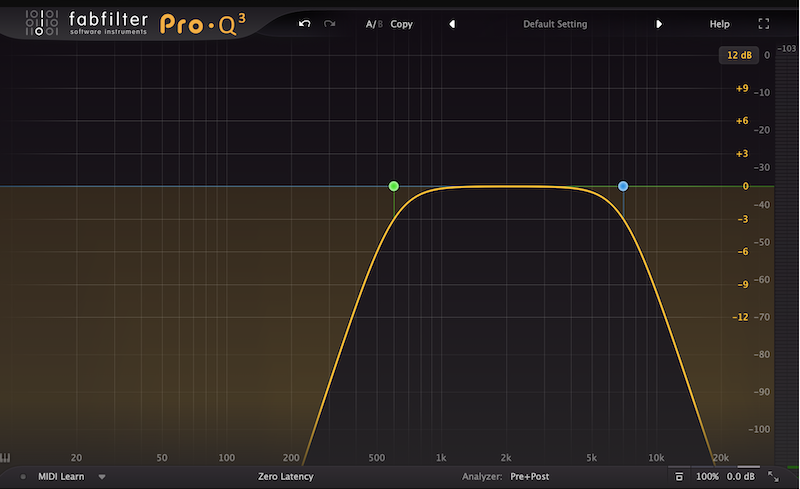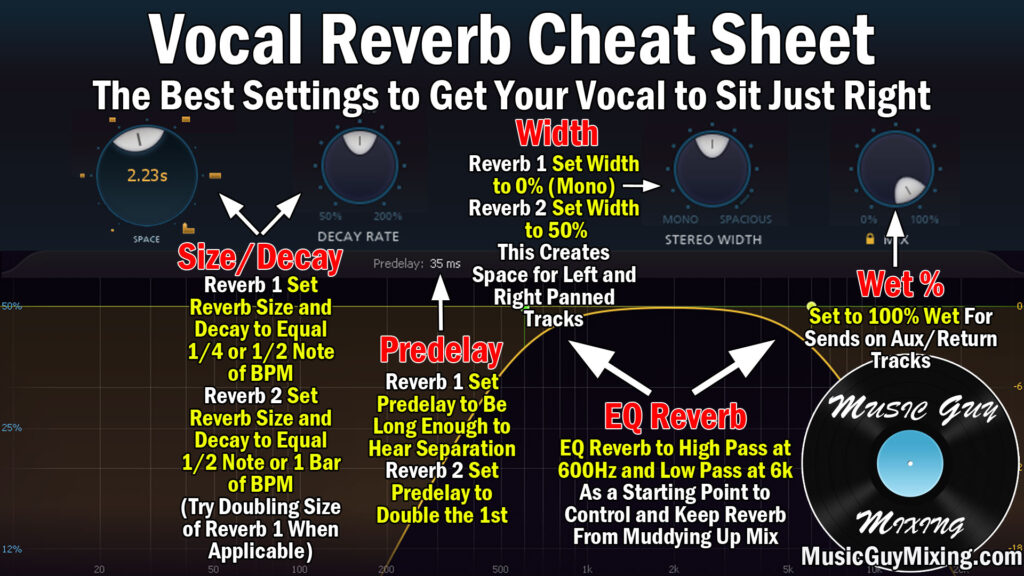To use reverb on vocals, add the reverb plugin to your vocal track and adjust the parameters to your liking. Reverb adds a sense of space and depth to vocals, making them sound fuller and more natural.
Here’s how you can use reverb on vocals: Reverb is an essential tool in the arsenal of any music producer or sound engineer. It can add life and character to any vocal performance, adding a sense of space and depth to the sound.
Reverb is particularly effective in giving vocals a natural, lifelike quality, making them sound like they were recorded in a real space. Whether you’re working on a solo project or producing a full band, adding reverb to your vocals can make a huge difference in the final mix. We’ll cover the basics of using reverb on vocals, and some techniques you can use to get the best results.
Types Of Reverb
Reverb can add depth and dimension to vocals, and there are different types of reverb to choose from depending on the desired effect. Plate, hall, and room reverb are popular options for vocal tracks, and adjusting the decay time and pre-delay can create a customized sound.
Reverb is one of the most essential effects used in music production, especially for vocals. It enables a vocalist to sound like they’re performing in different spaces, regardless of where they actually recorded their vocals. Understanding the various types of reverb will help you choose the most suitable type for your vocals. Below are the most common types of reverb, including their unique characteristics and how to use them.
Room Reverb
Room reverb is the most common type of reverb used in music production for vocals. It mimics the sound of a performer singing in a small space, such as a bedroom or a small studio. Room reverb creates early reflections, which are the first few echoes of a sound bouncing back from the walls, ceiling, and floor of a room. It has a short decay time, which means that the reverb tail fades quickly. Using a low-level room reverb can add a subtle sense of ambience to vocals.
Plate Reverb
Plate reverbs mimic the sound of a guitarist’s reverb, made by vibrations in a thin metal plate. Plate reverbs have an even frequency response and a relatively long decay time. They are ideal for creating a sense of space, and they make vocals sound fuller and less dry. Plate reverb, when used in moderation, can help to put vocals in the front of a mix.
Spring Reverb
Spring reverb is a type of reverb that used to be common in vintage guitar amps. It uses springs to create reverb effects. This type of reverb often sounds metallic or bright, making it suitable for retro or bright-sounding vocals. Spring reverb has a relatively short decay time, making vocals sound plucky and sharp. It is best used in rock or punk genres.
Hall Reverb
Hall reverb simulates the sound of a performer singing in a large concert hall, such as a cathedral or auditorium. This type of reverb creates a sense of vastness and space and is especially suitable for ballad songs or dramatic vocals. Hall reverb has a long decay time, which means that it sounds like the sound continues on and on. Using an excessively long hall reverb can muddy a mix, so it’s important to use it in moderation.
Convolution Reverb
Convolution reverb is a digital reverb that uses real-life acoustic spaces as a basis for its sound. It captures the exact sound and acoustic characteristics of a real-life space. Convolution reverb is excellent for creating a unique, ethereal environment for vocals. It has a long decay time, making vocals sound otherworldly. Convolution reverb works well for ambient music genres. In conclusion, experimenting with different types of reverb can help you find your unique sound. It’s always a good idea to use reverb in moderation and mix it carefully to avoid muddiness or competing frequencies. Knowing the different types of reverb and their unique characteristics will help you achieve the perfect ambience for your vocal recordings.

Credit: producelikeapro.com
How To Apply Reverb On Vocals
Reverb is an essential tool for bringing a sense of depth and space to vocal recordings. With the right application of reverb, you can transform a flat and lifeless vocal recording into a vibrant and lively performance that jumps out of the speakers. Here’s how to use reverb on vocals:
Setting Up Your Reverb Unit
The first step is to set up your reverb unit. Connect the unit to your mixing console and ensure that it’s receiving a signal from the vocal track. A good starting point is to set the reverb time to around 1.5 seconds.
Adjusting Pre-delay And Decay Parameters
The pre-delay and decay parameters are crucial when it comes to creating a natural-sounding reverb. Pre-delay is the amount of time it takes for the reverb to kick in after the vocal signal hits the reverb unit. Decay is the amount of time it takes for the reverb to fade away. Adjust these parameters until you achieve a sound that is both natural and pleasing to your ears.
Choosing The Right Reverb Type For Your Vocals
There are various types of reverb that you can use for vocals. Plate, hall, room, and spring are the most popular. Each type of reverb has a unique sonic character that can shape the overall tone of your recording. Experiment with different types of reverb to find the one that best complements your vocals.
Adjusting Reverb Levels
Once you’ve selected the right reverb type, it’s time to adjust the reverb levels. The right balance of dry and wet signals is crucial in achieving a balanced mix. A good way to achieve a proper balance is to start with the reverb level at 100% wet and gradually dial in the dry signal until the reverb sits comfortably within the mix.
Using Automation To Create Dynamic Reverb Effects
If you want to create dynamic reverb effects, you can use automation. This technique involves increasing the reverb level on certain words or phrases to highlight them within the mix. With this technique, you can create a sense of movement and interest within your vocals.
Tips For Using Reverb On Vocals
Reverb can add depth and dimension to vocals in a mix, but it’s important to use it correctly. Start with a small amount of reverb and adjust the decay time and pre-delay settings to avoid muddiness. EQ the reverb to fit the vocal’s frequency range and consider using a send/return channel for more control.
Reverb is a crucial tool for giving vocals a sense of space and depth. Proper use of reverb can take your vocal track to the next level by adding depth and character. However, it is essential to use it carefully, as overdoing it can result in a washed-out mix. In this guide, we will cover some tips and tricks to get the most out of your reverb on your vocal tracks.
Avoid Overdoing It
The key to using reverb on vocals is to avoid going overboard. This means you must be careful not to add too much of it to your vocal mix. Too much reverb can end up masking the vocals, causing it to sound weak and muddled. To avoid this, try starting with small amounts of reverb and working your way up until you find the perfect balance.
Use Reverb To Create Depth
Reverb can be used to create a sense of space and depth to your vocals. You can use reverb to simulate the sound of a larger room, creating the impression that you recorded the vocals in a more spacious area. To achieve this, add a small amount of reverb to your vocals, experiment with the different types of reverb (like hall, plate, or spring reverb), and adjust the wet/dry mix until you achieve the desired depth.
Layering Reverb For A Unique Sound
One technique that can help bring out the best in your vocal track is layering. By layering multiple instances of a reverb effect, you can create a unique and exciting vocal sound. You can use different types of reverb, such as a small delay and a long hall reverb. Layering multiple types of reverb can help the vocal stand out while adding depth and character.
Using Reverb To Create Harmonies
Another cool way to use reverb is to create harmonies. You can achieve this by duplicating the main vocal track and applying different levels of reverb to each track. The first vocal track is the main one, and the second track is adjusted to have more reverb. This creates a sense of depth and spatiality to your track, giving it a fuller sound. With this technique, you can create an impressive harmony sound with just one vocal track. To sum up, using reverb on vocals is crucial for creating depth, character, and space to your vocal tracks. As discussed, you need always be careful not to overdo it to avoid a washed-out mix. Instead, experiment with small amounts of reverb and different types of reverb until you find the perfect balance. Finally, remember to consider layering reverb and duplicating tracks to achieve unique and outstanding vocal sounds.

Credit: www.musicguymixing.com

Credit: www.youtube.com
Frequently Asked Questions On How To Use Reverb On Vocals
How Do You Use Reverb Effectively?
To use reverb effectively, start by choosing the right type of reverb for your sound. Adjust the decay time and pre-delay to create a natural sounding space. Use EQ to shape the reverb and adjust the wet/dry mix to blend the reverb with the original sound.
Experiment and listen critically to achieve the desired effect.
What Reverb Is Most Used For Vocals?
The most commonly used reverb for vocals is plate reverb. It adds warmth and depth to the vocals, creating a sense of space and richness. Plate reverb produces a smooth, natural-sounding effect that complements most vocals.
What Are Good Reverb Settings?
Good reverb settings depend on the type of music and the desired effect. For example, shorter decay times work well for a more natural sound, whereas longer decay times are good for creating a space-like effect. It’s also important to adjust the wet/dry mix and pre-delay settings to achieve the desired balance and clarity.
Experimentation is key.
Do All Singers Use Reverb?
Most singers use reverb to enhance their vocals and add a sense of depth to their performance. However, some singers choose not to use reverb depending on their personal preference or the style of music they are performing.
Conclusion
To sum up, reverb is a powerful tool that can take your vocal recording to the next level. It can add depth, space, and emotion to your vocals, making them sound more professional and engaging. By experimenting with different types of reverb and adjusting the settings, you can find the sweet spot that works best for your vocals.
Remember to keep it subtle and avoid overusing it, as too much reverb can make your vocals sound muddy or distant. With these tips in mind, you’ll be able to use reverb like a pro and create captivating vocal recordings that stand out from the crowd.